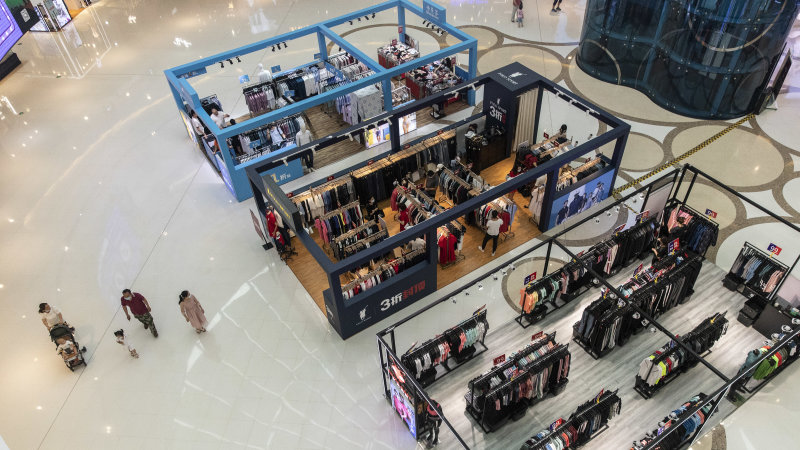
Limited leverage
Quzhou, a city in the eastern province of Zhejiang, said that 18.5 million yuan of vouchers issued by the local government were used by local residents, generating a total spend of 102 million yuan, which means every 1 yuan of vouchers led to total spending of 5.5 yuan, or additional spending of 4.5 yuan. Other cities including Hangzhou, Zhengzhou and Jincheng said spending generated by the use of vouchers amounted to 10 times their face value.
But some analysts believe that that in many cases the leverage effect isn’t that significant. A study carried out in Nanjing from March to May showed that 1 yuan of vouchers generated a total spend of just 2.9 yuan. Guan Lixin, a researcher with a Ministry of Commerce-linked think tank who wrote the report, told Caixin that some cities may be exaggerating the leverage effect because they are taking into account spending driven by coupons offered by businesses.
The aggregate effect of vouchers and coupons is limited because the consumption they trigger accounts for a tiny share of overall spending, said Xu Qiyuan, a researcher with the Chinese Academy of Social Sciences (CASS), another state-backed think tank. Assuming 1 yuan of vouchers leads to a total spend of 2 to 3 yuan, that would only amount to “tens of billions of yuan” of consumption while government data showed that domestic retail sales in April alone were 2.8 trillion yuan.
While government subsidies and aid in many countries have focused on helping those most in need, such as the unemployed and low-income households, via cash or welfare payments, in China, the focus of the voucher initiative has been on supporting businesses.
Sectors that suffered the most during the COVID-19 outbreak appear to have been the major beneficiaries. Xu from CASS studied the voucher policies of 42 cities and found that 81 per cent distributed vouchers to spend on eating out, and 73 per cent and 48 per cent offered incentives for retailing and tourism. Other sectors that benefited include hotels, culture, car sales, and appliances.
This shows that “consideration for industries and companies is the starting point of the consumer voucher policy,” Xu said.
There are also strings attached to many of the vouchers. Kaifu district in the city of Changsha, Hunan province, issued coupons worth 2 million yuan but they were in the form of fuel card subsidies for consumers who bought cars at local dealerships during the Changsha auto show.
Digital discrimination
Some analysts have pointed out the system also has the potential to disadvantage those on low incomes. Most vouchers are distributed via digital payment platforms such as WeChat and Alipay rather than through paper coupons, which may make it difficult for low-income consumers to access as they are less likely to use digital payment. In addition, most vouchers can only be used when spending reaches a certain threshold.
While discounts may support consumer spending, they aren’t doing much to help impoverished and low-income families, or those living in rural areas who may have to spend money to travel to city centres where most vouchers can be spent.
Economists say vouchers and coupons are ineffective in offsetting the drop in income suffered by millions of people furloughed or unable to work during the outbreak. Official data show that the surveyed urban unemployment rate rose to 6 per cent in April, the second-highest reading in available data going back to January 2017. The actual scale of joblessness may be larger as the official figure excludes millions of migrants who leave their hometowns to work. Many of those have been unable to find jobs as factories that closed during the epidemic have not fully recovered.
So far, only around 13 cities have made specific provision for low-income families and the value of vouchers targeted at this sector has amounted to less than 200 million yuan, according to Caixin calculations. Many analysts are now calling for local governments to undertake a large-scale rollout of vouchers or cash transfers to those in need.
Compared with the scale of the stimulus and relief conferred on the corporate sector, fiscal subsidies to individuals have been much smaller. As of the middle of April, fiscal stimulus issued by authorities had reached 1.4 trillion yuan, according to calculations (link in Chinese) by Wang Tao, chief China economist at UBS Group AG. But at least 1.1 trillion yuan of that was targeted at the corporate sector in the form of tax and fee cuts, and other financial relief.
Wang expects policymakers will soon unveil a further stimulus package worth around 2.2 trillion yuan, but only 0.2 trillion yuan to 0.3 trillion yuan is likely to be targeted at helping low-income people through direct cash transfers or consumption subsidies.
The concept of consumption vouchers was introduced by the central government during the 2008 global financial crisis to boost spending and support economic growth. This time around, it’s been local governments who have taken the lead and as yet there have been no national-level policies.
That’s meant local governments have had to foot the bill from their own resources and given their deteriorating fiscal positions as tax revenue slumps amid the economic slowdown, they have little spare cash. As a result, the issuance of vouchers is unlikely to become a more permanent fixture.
caixin
"consumption" - Google News
May 21, 2020 at 08:54AM
https://ift.tt/3bWqDix
China wrestles with best way to gee up consumption - The Australian Financial Review
"consumption" - Google News
https://ift.tt/2WkKCBC
https://ift.tt/2YCP29R
Bagikan Berita Ini














0 Response to "China wrestles with best way to gee up consumption - The Australian Financial Review"
Post a Comment